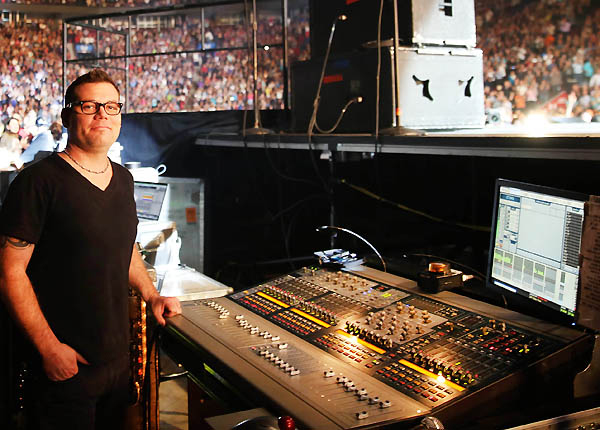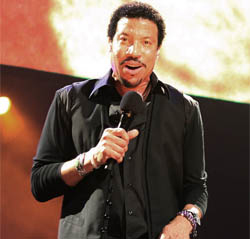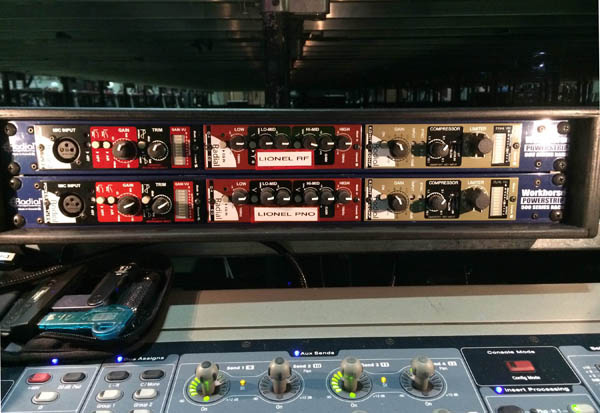Over Dan Housel’s two-year stint as monitor engineer for Lionel Richie, he’s sought constant improvement in presenting the iconic singer’s classic, distinctive vocal signature. We spoke recently, just prior to the final show at London’s O2 arena on the European leg of Richie’s latest tour, about what he’s been up to lately in that regard.
“I mix on digital consoles – I’m an Avid Profile user – but having learned on analog gear and having spent time working in the studio, there are certain things I miss about analog, a certain ‘flavor’ lacking on digital preamps that analog pres have,” he notes.
It’s something the LA-based engineer says that he’s come to notice while running monitors for other acts in his 15-plus years in the business, including work with blues guitarist Keb’ Mo’, Filter, Pitbull and Maynard James Keenan’s bands Puscifer and A Perfect Circle. During Richie’s gigs, particularly on fly dates, Housel continues, he started considering how to add that same type of flavor, not only to better the overall sound for Richie and his band, but to allow him to compensate at times when Richie’s approach to performance and sonic considerations collide.
Evaluating Options
“We sometimes have struggles,” he says, explaining that at times Richie experiences difficulty finding himself in the mix the way he wants, which is a function of his desire to connect with the audience. “He’s a Shure SM58 user, which is – for lack of a better description – a very active microphone on stage,” Housel continues. “He moves the mic around a lot, from in front of his face to down by his chest. But when I asked him about it, he looked at me and said, ‘Baby boy, they don’t want to see the microphone, they want to see my face’.”

Housel mitigated the problem by backing off on reverb and turning on downstage wedges to provide additional presence to compliment Richie’s in-ear monitors, and he also began looking for other ways to add more definition. Over time, he’s floated a variety of other solutions with fellow engineers, including Avalon 737 mic preamps that he uses on Keenan’s vocals during A Perfect Circle gigs while mixing on an Avid Venue SC48.
“The 737s are fairly commonplace, but I needed two channels because Lionel uses two microphones during performances, a hard-wired 58 at the piano and a wireless 58,” he says, noting that carrying two of the units wasn’t a compact enough solution and adding, “They’re a bit sensitive for travel.”
The search also included BAE 1073 and Midas XL42 preamps. “I’ve seen the XL42 used for the same application, but they’re discontinued now and the few people who are willing to part with them are asking a handsome price, so I did more research. The name Radial came up during a discussion with one of the Puscifer guys, who suggested the company’s 500 series preamps.”
Already a long-time user of Radial Engineering direct boxes, Housel reached out to company president Peter Janis, who he’d met during his own time as a manufacturer’s representative.
“I tested out a Radial PowerPre along with a Q4 four-band EQ and Komit compressor/limiter during pre-production for the European leg,” he says. “I could definitely hear that there was more separation compared to the console preamps, but I was still considering the more sensitive tube gear. I was sitting in my hotel with the PowerPre chassis in hand, researching the PowerTube and thinking that, if they’re built the same as the PowerPre, they’re going to be all right.”
Depth & Detail
As it’s name implies, the PowerTube incorporates a 12AX7 tube drive and a Jensen Transformer input. “To me it sounded like the first time I listened to a hi-def audio recording,” he states. “It was just next-level separation, depth and detail. I also added the Q4, but I don’t use EQ within Lionel’s vocal signal chain, so that’s bypassed. Again, he moves the microphone around a lot, so if I EQ for one mic position – at the chest or higher up – when it’s in the opposite position, I’m down the river.”
The 500 series rack form factor was another plus in addition to the sonic characteristics and durability, and as a result, dual sets of PowerTube preamp, Q4 EQ and Komit comp/limiter modules have achieved the desired result in Radial Workhouse 500 series racks that occupy just 2RU.
Richie noticed a difference immediately, Housel notes. “He pulled his in ears out, stopped the band, got on the mic and asked me what I’d done differently. I told him we spent a little money to make his vocals sound better and he started singing alone, then stopped and said, ‘I’m gonna sue your ass for not having these before’.”
Housel details the overall vocal chain for Richie: “We go out of the 58 and hit the split. Then rather than running into the stage rack for my Profile, we hit a cross patch that’s also carrying all 10 channels of our Pro Tools rig.” That, he adds, varies from song to song, mostly providing syncopated and rhythmic support – “shaker and tambourine, ear candy” – and goes directly into the front of house rack on line level inputs.
After the cross patch, the signal goes to a PowerTube, the bypassed Q4 and then to a Komit. “I set the compression at 3:1 on a slow attack cycle for the vocal so it really only grabs the latter portion of the vocal, but the compressor’s output circuit is giving us another 6 dB,” he explains. “With Lionel, the mic pre isn’t necessarily your best friend, especially with that 58 – it’s a bit of a fire hose, and there’s a risk of more ambient than direct sound at times – so I try to get as much output gain in as many places as possible.
“I don’t EQ his voice within the console either, with the exception of the high pass filter set at 160,” he continues. “It’s boomy at times, but I started inserting a McDSP MC2000 multiband compressor plug-in about a year after I started. Each compression band also provides some output level, so it does work like an equalizer in the respect that you can give it more or less gain within the signal chain, which helps make up for when Lionel holds the mic at his chest.”





















